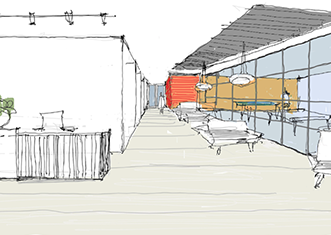Home office is here to stay: flexible, agile and asynchronous.
Since the beginning of the pandemic, companies have had to adapt to keep up. The concept of hybrid working is not new, but it has very quickly become the "new normal". We now work from anywhere, including home.
But what exactly is a hybrid workspace?
In a hybrid office, in-office work and remote work go hand in hand. Companies have different departments, some of whose employees are tied to the office, but others can also work at their desks at home. A hybrid office means flexibility and freedom. Now you might ask yourself: and what about productivity? Studies show that teleworkers are 20-50 per cent more productive than their full-time office-based colleagues.
So how exactly do you implement a hybrid office?
Companies need to start making long-term plans to implement a hybrid office. The following steps are essential:
1. Establish a hybrid office policy
It is important to define a policy and find out exactly which work positions can work from home and which cannot. This can mean individualized policies for each employee, but also events such as weekly meetings that everyone must attend in some form.
2. Reconfiguring the office space
The office space also needs to adapt to the new needs. With fewer staff working in the office, the previously necessary size of the office can also be reduced. In doing so, the new space should have maximum flexibility to enable quick rearrangement. The room conditions adapted to the specific needs are ensuring maximum productivity. In no time at all, focused individual work can be turned into a space for interdisciplinary exchange during exercises and meetings.
3. Investment in tools and technology
What investments will I need to make in hardware and software? What licenses I'll require? A remote working environment must be actively designed. With the help of apps, real-time communication between employees should be guaranteed, but also a place should be created where the remote team can collaborate and jointly access documents.

And why is the integration of a hybrid office so advantageous?
The biggest plus is probably the increased productivity of the employees, which is partly due to the absence of interruptions from colleagues. In addition, a flexible workplace goes hand in hand with reduced stress levels and the teams are happier and more motivated. Is there more to it? Sure. A hybrid workplace drastically reduces operating costs, as real estate costs are reduced due to the smaller footprint and there are fewer physical office needs.
The catch?
Well, there isn't one. But of course, with change comes challenge. Creating a regular routine is probably one of the biggest challenges of hybrid working. Limited personal time in the workplace, for example, interacting more intimately with colleagues and maintaining social contacts in the office can also prove more challenging.
However, challenge does not mean impossibility. The highest level of coordination, communication and structure makes hybrid working future-proof.
Hybrid makes it possible.
You can do it too.








